1989 FORD FIESTA wheel bolts
[x] Cancel search: wheel boltsPage 196 of 296
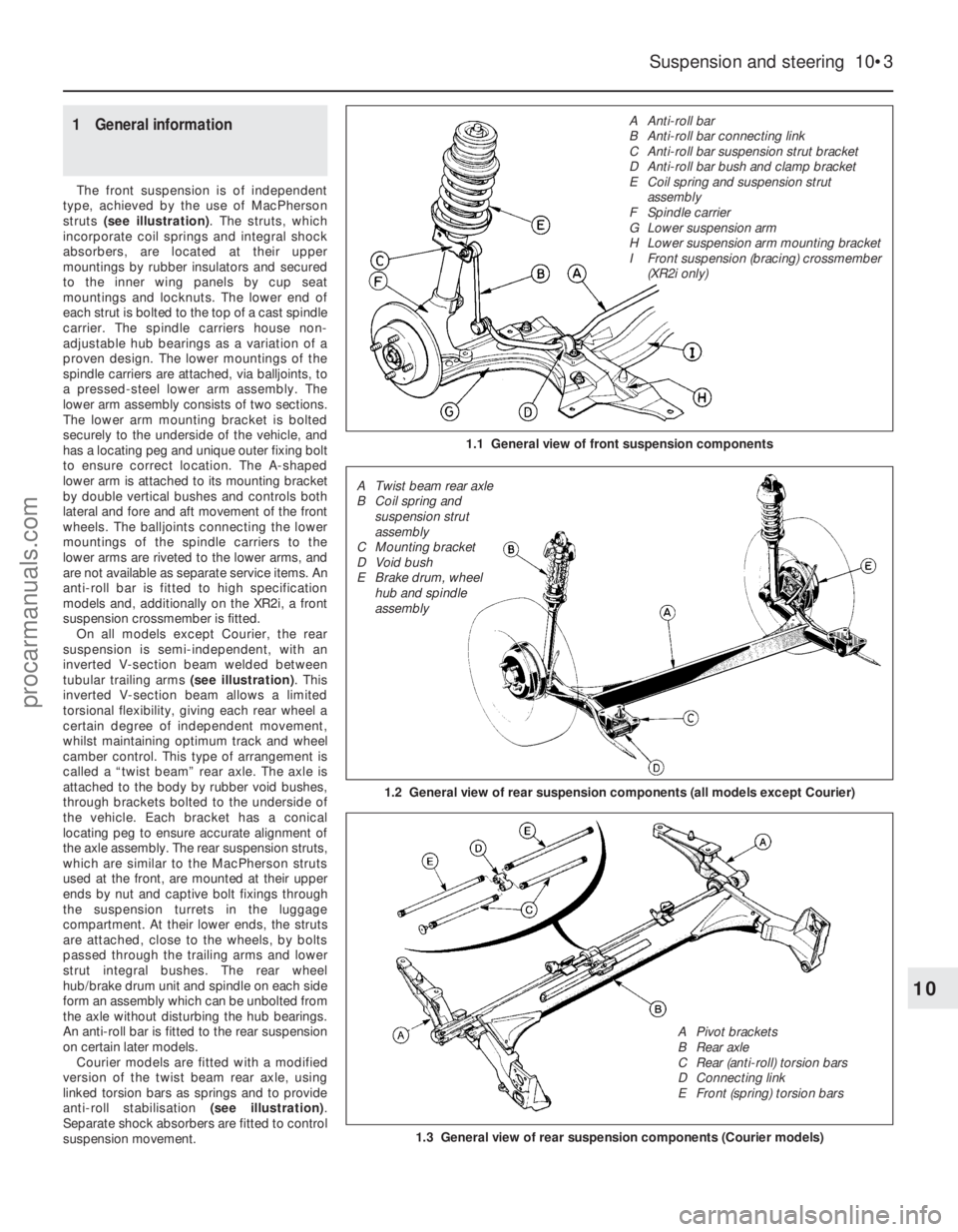
1 General information
The front suspension is of independent
type, achieved by the use of MacPherson
struts (see illustration) . The struts, which
incorporate coil springs and integral shock
absorbers, are located at their upper
mountings by rubber insulators and secured
to the inner wing panels by cup seat
mountings and locknuts. The lower end of
each strut is bolted to the top of a cast spindle
carrier. The spindle carriers house non-
adjustable hub bearings as a variation of a
proven design. The lower mountings of the
spindle carriers are attached, via balljoints, to
a pressed-steel lower arm assembly. The
lower arm assembly consists of two sections.
The lower arm mounting bracket is bolted
securely to the underside of the vehicle, and
has a locating peg and unique outer fixing bolt
to ensure correct location. The A-shaped
lower arm is attached to its mounting bracket
by double vertical bushes and controls both
lateral and fore and aft movement of the front
wheels. The balljoints connecting the lower
mountings of the spindle carriers to the
lower arms are riveted to the lower arms, and
are not available as separate service items. An
anti-roll bar is fitted to high specification
models and, additionally on the XR2i, a front
suspension crossmember is fitted. On all models except Courier, the rear
suspension is semi-independent, with an
inverted V-section beam welded between
tubular trailing arms (see illustration). This
inverted V-section beam allows a limited
torsional flexibility, giving each rear wheel a
certain degree of independent movement,
whilst maintaining optimum track and wheel
camber control. This type of arrangement is
called a “twist beam” rear axle. The axle is
attached to the body by rubber void bushes,
through brackets bolted to the underside of
the vehicle. Each bracket has a conical
locating peg to ensure accurate alignment of
the axle assembly. The rear suspension struts,
which are similar to the MacPherson struts
used at the front, are mounted at their upper
ends by nut and captive bolt fixings through
the suspension turrets in the luggage
compartment. At their lower ends, the struts
are attached, close to the wheels, by bolts
passed through the trailing arms and lower
strut integral bushes. The rear wheel
hub/brake drum unit and spindle on each side
form an assembly which can be unbolted from
the axle without disturbing the hub bearings.
An anti-roll bar is fitted to the rear suspension
on certain later models.
Courier models are fitted with a modified
version of the twist beam rear axle, using
linked torsion bars as springs and to provide
anti-roll stabilisation (see illustration).
Separate shock absorbers are fitted to control
suspension movement.
Suspension and steering 10•3
1.1 General view of front suspension components
1.3 General view of rear suspension components (Courier models)
1.2 General view of rear suspension components (all models except Cour\
ier)
10
1595Ford Fiesta Remake A Anti-roll bar
B Anti-roll bar connecting link
C Anti-roll bar suspension strut bracket
D Anti-roll bar bush and clamp bracket
E Coil spring and suspension strut
assembly
F Spindle carrier
G Lower suspension arm
H Lower suspension arm mounting bracket
I Front suspension (bracing) crossmember (XR2i only)
A Twist beam rear axle
B Coil spring and suspension strut
assembly
C Mounting bracket
D Void bush
E Brake drum, wheel hub and spindle
assembly
A Pivot brackets
B Rear axle
C Rear (anti-roll) torsion bars
D Connecting link
E Front (spring) torsion barsprocarmanuals.com
http://vnx.su
Page 197 of 296
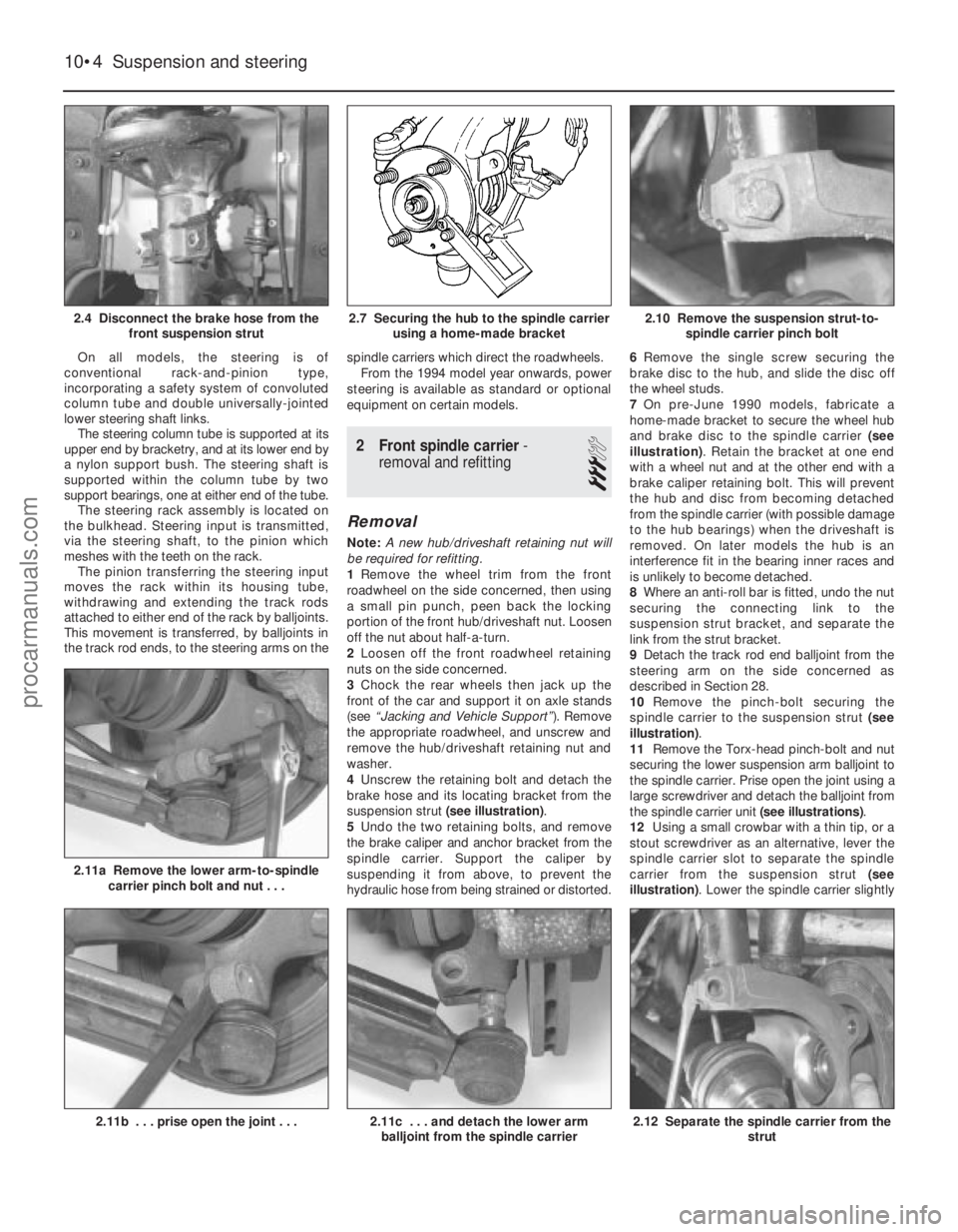
On all models, the steering is of
conventional rack-and-pinion type,
incorporating a safety system of convoluted
column tube and double universally-jointed
lower steering shaft links. The steering column tube is supported at its
upper end by bracketry, and at its lower end by
a nylon support bush. The steering shaft is
supported within the column tube by two
support bearings, one at either end of the tube. The steering rack assembly is located on
the bulkhead. Steering input is transmitted,
via the steering shaft, to the pinion which
meshes with the teeth on the rack. The pinion transferring the steering input
moves the rack within its housing tube,
withdrawing and extending the track rods
attached to either end of the rack by balljoints.
This movement is transferred, by balljoints in
the track rod ends, to the steering arms on the spindle carriers which direct the roadwheels.
From the 1994 model year onwards, power
steering is available as standard or optional
equipment on certain models.
2 Front spindle carrier -
removal and refitting
3
Removal
Note: A new hub/driveshaft retaining nut will
be required for refitting.
1 Remove the wheel trim from the front
roadwheel on the side concerned, then using
a small pin punch, peen back the locking
portion of the front hub/driveshaft nut. Loosen
off the nut about half-a-turn.
2 Loosen off the front roadwheel retaining
nuts on the side concerned.
3 Chock the rear wheels then jack up the
front of the car and support it on axle stands
(see “Jacking and Vehicle Support” ). Remove
the appropriate roadwheel, and unscrew and
remove the hub/driveshaft retaining nut and
washer.
4 Unscrew the retaining bolt and detach the
brake hose and its locating bracket from the
suspension strut (see illustration).
5 Undo the two retaining bolts, and remove
the brake caliper and anchor bracket from the
spindle carrier. Support the caliper by
suspending it from above, to prevent the
hydraulic hose from being strained or distorted. 6
Remove the single screw securing the
brake disc to the hub, and slide the disc off
the wheel studs.
7 On pre-June 1990 models, fabricate a
home-made bracket to secure the wheel hub
and brake disc to the spindle carrier (see
illustration) . Retain the bracket at one end
with a wheel nut and at the other end with a
brake caliper retaining bolt. This will prevent
the hub and disc from becoming detached
from the spindle carrier (with possible damage
to the hub bearings) when the driveshaft is
removed. On later models the hub is an
interference fit in the bearing inner races and
is unlikely to become detached.
8 Where an anti-roll bar is fitted, undo the nut
securing the connecting link to the
suspension strut bracket, and separate the
link from the strut bracket.
9 Detach the track rod end balljoint from the
steering arm on the side concerned as
described in Section 28.
10 Remove the pinch-bolt securing the
spindle carrier to the suspension strut (see
illustration) .
11 Remove the Torx-head pinch-bolt and nut
securing the lower suspension arm balljoint to
the spindle carrier. Prise open the joint using a
large screwdriver and detach the balljoint from
the spindle carrier unit (see illustrations).
12 Using a small crowbar with a thin tip, or a
stout screwdriver as an alternative, lever the
spindle carrier slot to separate the spindle
carrier from the suspension strut (see
illustration) . Lower the spindle carrier slightly
10•4Suspension and steering
2.12 Separate the spindle carrier from the
strut2.11c . . . and detach the lower armballjoint from the spindle carrier2.11b . . . prise open the joint . . .
2.11a Remove the lower arm-to-spindle carrier pinch bolt and nut . . .
2.10 Remove the suspension strut-to- spindle carrier pinch bolt2.7 Securing the hub to the spindle carrier using a home-made bracket2.4 Disconnect the brake hose from the front suspension strut
1595Ford Fiesta Remakeprocarmanuals.com
http://vnx.su
Page 198 of 296
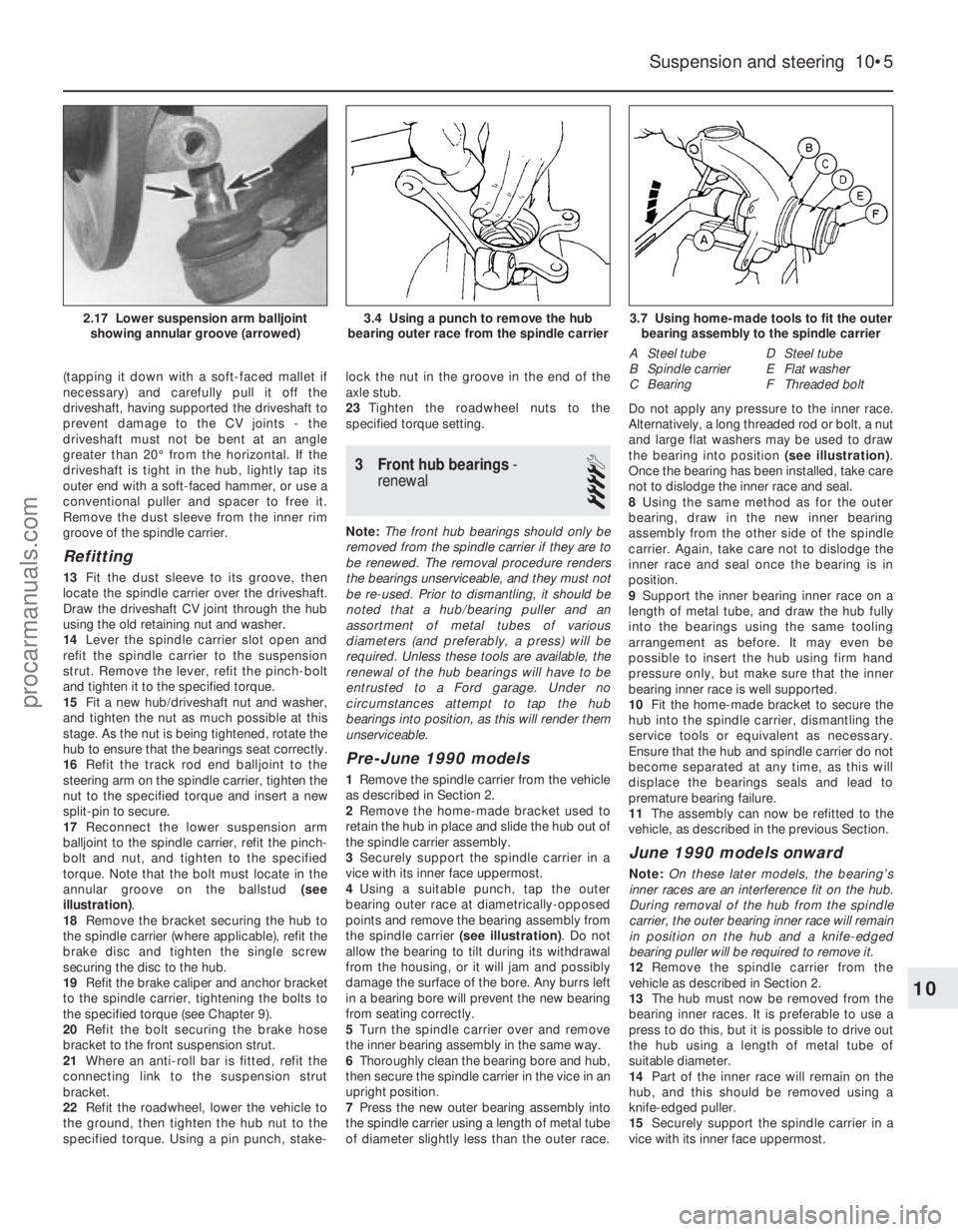
(tapping it down with a soft-faced mallet if
necessary) and carefully pull it off the
driveshaft, having supported the driveshaft to
prevent damage to the CV joints - the
driveshaft must not be bent at an angle
greater than 20° from the horizontal. If the
driveshaft is tight in the hub, lightly tap its
outer end with a soft-faced hammer, or use a
conventional puller and spacer to free it.
Remove the dust sleeve from the inner rim
groove of the spindle carrier.
Refitting
13Fit the dust sleeve to its groove, then
locate the spindle carrier over the driveshaft.
Draw the driveshaft CV joint through the hub
using the old retaining nut and washer.
14 Lever the spindle carrier slot open and
refit the spindle carrier to the suspension
strut. Remove the lever, refit the pinch-bolt
and tighten it to the specified torque.
15 Fit a new hub/driveshaft nut and washer,
and tighten the nut as much possible at this
stage. As the nut is being tightened, rotate the
hub to ensure that the bearings seat correctly.
16 Refit the track rod end balljoint to the
steering arm on the spindle carrier, tighten the
nut to the specified torque and insert a new
split-pin to secure.
17 Reconnect the lower suspension arm
balljoint to the spindle carrier, refit the pinch-
bolt and nut, and tighten to the specified
torque. Note that the bolt must locate in the
annular groove on the ballstud (see
illustration) .
18 Remove the bracket securing the hub to
the spindle carrier (where applicable), refit the
brake disc and tighten the single screw
securing the disc to the hub.
19 Refit the brake caliper and anchor bracket
to the spindle carrier, tightening the bolts to
the specified torque (see Chapter 9).
20 Refit the bolt securing the brake hose
bracket to the front suspension strut.
21 Where an anti-roll bar is fitted, refit the
connecting link to the suspension strut
bracket.
22 Refit the roadwheel, lower the vehicle to
the ground, then tighten the hub nut to the
specified torque. Using a pin punch, stake- lock the nut in the groove in the end of the
axle stub.
23
Tighten the roadwheel nuts to the
specified torque setting.
3 Front hub bearings -
renewal
4
Note: The front hub bearings should only be
removed from the spindle carrier if they are to
be renewed. The removal procedure renders
the bearings unserviceable, and they must not
be re-used. Prior to dismantling, it should be
noted that a hub/bearing puller and an
assortment of metal tubes of various
diameters (and preferably, a press) will be
required. Unless these tools are available, the
renewal of the hub bearings will have to be
entrusted to a Ford garage. Under no
circumstances attempt to tap the hub
bearings into position, as this will render them
unserviceable.
Pre-June 1990 models
1 Remove the spindle carrier from the vehicle
as described in Section 2.
2 Remove the home-made bracket used to
retain the hub in place and slide the hub out of
the spindle carrier assembly.
3 Securely support the spindle carrier in a
vice with its inner face uppermost.
4 Using a suitable punch, tap the outer
bearing outer race at diametrically-opposed
points and remove the bearing assembly from
the spindle carrier (see illustration). Do not
allow the bearing to tilt during its withdrawal
from the housing, or it will jam and possibly
damage the surface of the bore. Any burrs left
in a bearing bore will prevent the new bearing
from seating correctly.
5 Turn the spindle carrier over and remove
the inner bearing assembly in the same way.
6 Thoroughly clean the bearing bore and hub,
then secure the spindle carrier in the vice in an
upright position.
7 Press the new outer bearing assembly into
the spindle carrier using a length of metal tube
of diameter slightly less than the outer race. Do not apply any pressure to the inner race.
Alternatively, a long threaded rod or bolt, a nut
and large flat washers may be used to draw
the bearing into position
(see illustration).
Once the bearing has been installed, take care
not to dislodge the inner race and seal.
8 Using the same method as for the outer
bearing, draw in the new inner bearing
assembly from the other side of the spindle
carrier. Again, take care not to dislodge the
inner race and seal once the bearing is in
position.
9 Support the inner bearing inner race on a
length of metal tube, and draw the hub fully
into the bearings using the same tooling
arrangement as before. It may even be
possible to insert the hub using firm hand
pressure only, but make sure that the inner
bearing inner race is well supported.
10 Fit the home-made bracket to secure the
hub into the spindle carrier, dismantling the
service tools or equivalent as necessary.
Ensure that the hub and spindle carrier do not
become separated at any time, as this will
displace the bearings seals and lead to
premature bearing failure.
11 The assembly can now be refitted to the
vehicle, as described in the previous Section.
June 1990 models onward
Note: On these later models, the bearing’s
inner races are an interference fit on the hub.
During removal of the hub from the spindle
carrier, the outer bearing inner race will remain
in position on the hub and a knife-edged
bearing puller will be required to remove it.
12 Remove the spindle carrier from the
vehicle as described in Section 2.
13 The hub must now be removed from the
bearing inner races. It is preferable to use a
press to do this, but it is possible to drive out
the hub using a length of metal tube of
suitable diameter.
14 Part of the inner race will remain on the
hub, and this should be removed using a
knife-edged puller.
15 Securely support the spindle carrier in a
vice with its inner face uppermost.
Suspension and steering 10•5
3.7 Using home-made tools to fit the outer bearing assembly to the spindle carrier
A Steel tube
B Spindle carrier
C Bearing D Steel tube
E Flat washer
F Threaded bolt
3.4 Using a punch to remove the hub
bearing outer race from the spindle carrier2.17 Lower suspension arm balljoint showing annular groove (arrowed)
10
1595Ford Fiesta Remakeprocarmanuals.com
http://vnx.su
Page 199 of 296
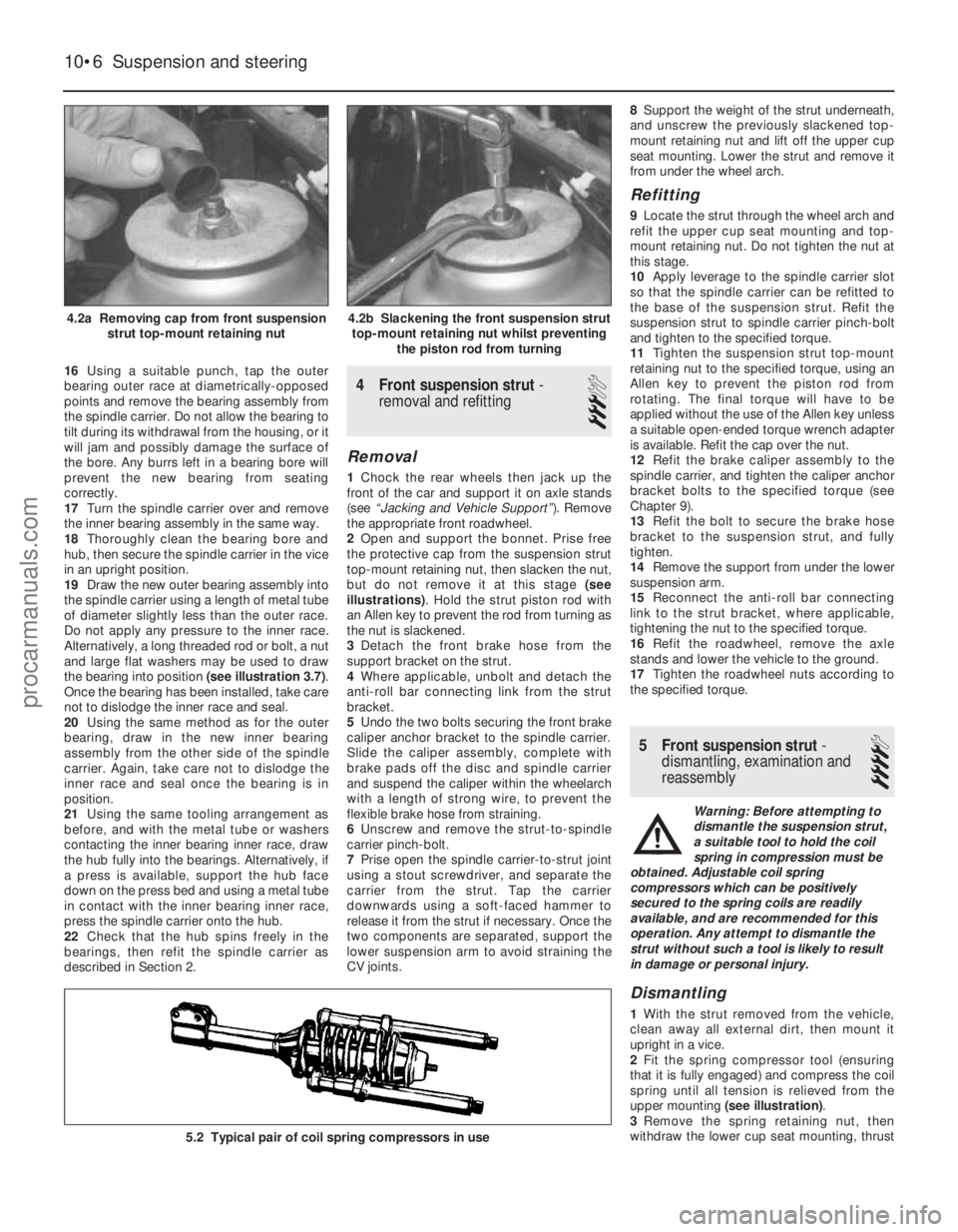
16Using a suitable punch, tap the outer
bearing outer race at diametrically-opposed
points and remove the bearing assembly from
the spindle carrier. Do not allow the bearing to
tilt during its withdrawal from the housing, or it
will jam and possibly damage the surface of
the bore. Any burrs left in a bearing bore will
prevent the new bearing from seating
correctly.
17 Turn the spindle carrier over and remove
the inner bearing assembly in the same way.
18 Thoroughly clean the bearing bore and
hub, then secure the spindle carrier in the vice
in an upright position.
19 Draw the new outer bearing assembly into
the spindle carrier using a length of metal tube
of diameter slightly less than the outer race.
Do not apply any pressure to the inner race.
Alternatively, a long threaded rod or bolt, a nut
and large flat washers may be used to draw
the bearing into position (see illustration 3.7).
Once the bearing has been installed, take care
not to dislodge the inner race and seal.
20 Using the same method as for the outer
bearing, draw in the new inner bearing
assembly from the other side of the spindle
carrier. Again, take care not to dislodge the
inner race and seal once the bearing is in
position.
21 Using the same tooling arrangement as
before, and with the metal tube or washers
contacting the inner bearing inner race, draw
the hub fully into the bearings. Alternatively, if
a press is available, support the hub face
down on the press bed and using a metal tube
in contact with the inner bearing inner race,
press the spindle carrier onto the hub.
22 Check that the hub spins freely in the
bearings, then refit the spindle carrier as
described in Section 2.4 Front suspension strut -
removal and refitting
3
Removal
1 Chock the rear wheels then jack up the
front of the car and support it on axle stands
(see “Jacking and Vehicle Support” ). Remove
the appropriate front roadwheel.
2 Open and support the bonnet. Prise free
the protective cap from the suspension strut
top-mount retaining nut, then slacken the nut,
but do not remove it at this stage (see
illustrations) . Hold the strut piston rod with
an Allen key to prevent the rod from turning as
the nut is slackened.
3 Detach the front brake hose from the
support bracket on the strut.
4 Where applicable, unbolt and detach the
anti-roll bar connecting link from the strut
bracket.
5 Undo the two bolts securing the front brake
caliper anchor bracket to the spindle carrier.
Slide the caliper assembly, complete with
brake pads off the disc and spindle carrier
and suspend the caliper within the wheelarch
with a length of strong wire, to prevent the
flexible brake hose from straining.
6 Unscrew and remove the strut-to-spindle
carrier pinch-bolt.
7 Prise open the spindle carrier-to-strut joint
using a stout screwdriver, and separate the
carrier from the strut. Tap the carrier
downwards using a soft-faced hammer to
release it from the strut if necessary. Once the
two components are separated, support the
lower suspension arm to avoid straining the
CV joints. 8
Support the weight of the strut underneath,
and unscrew the previously slackened top-
mount retaining nut and lift off the upper cup
seat mounting. Lower the strut and remove it
from under the wheel arch.
Refitting
9 Locate the strut through the wheel arch and
refit the upper cup seat mounting and top-
mount retaining nut. Do not tighten the nut at
this stage.
10 Apply leverage to the spindle carrier slot
so that the spindle carrier can be refitted to
the base of the suspension strut. Refit the
suspension strut to spindle carrier pinch-bolt
and tighten to the specified torque.
11 Tighten the suspension strut top-mount
retaining nut to the specified torque, using an
Allen key to prevent the piston rod from
rotating. The final torque will have to be
applied without the use of the Allen key unless
a suitable open-ended torque wrench adapter
is available. Refit the cap over the nut.
12 Refit the brake caliper assembly to the
spindle carrier, and tighten the caliper anchor
bracket bolts to the specified torque (see
Chapter 9).
13 Refit the bolt to secure the brake hose
bracket to the suspension strut, and fully
tighten.
14 Remove the support from under the lower
suspension arm.
15 Reconnect the anti-roll bar connecting
link to the strut bracket, where applicable,
tightening the nut to the specified torque.
16 Refit the roadwheel, remove the axle
stands and lower the vehicle to the ground.
17 Tighten the roadwheel nuts according to
the specified torque.
5 Front suspension strut -
dismantling, examination and
reassembly
4
Warning: Before attempting to
dismantle the suspension strut,
a suitable tool to hold the coil
spring in compression must be
obtained. Adjustable coil spring
compressors which can be positively
secured to the spring coils are readily
available, and are recommended for this
operation. Any attempt to dismantle the
strut without such a tool is likely to result
in damage or personal injury.
Dismantling
1 With the strut removed from the vehicle,
clean away all external dirt, then mount it
upright in a vice.
2 Fit the spring compressor tool (ensuring
that it is fully engaged) and compress the coil
spring until all tension is relieved from the
upper mounting (see illustration) .
3 Remove the spring retaining nut, then
withdraw the lower cup seat mounting, thrust
10•6 Suspension and steering
5.2 Typical pair of coil spring compressors in use
4.2b Slackening the front suspension strut
top-mount retaining nut whilst preventing the piston rod from turning4.2a Removing cap from front suspensionstrut top-mount retaining nut
1595Ford Fiesta Remakeprocarmanuals.com
http://vnx.su
Page 200 of 296
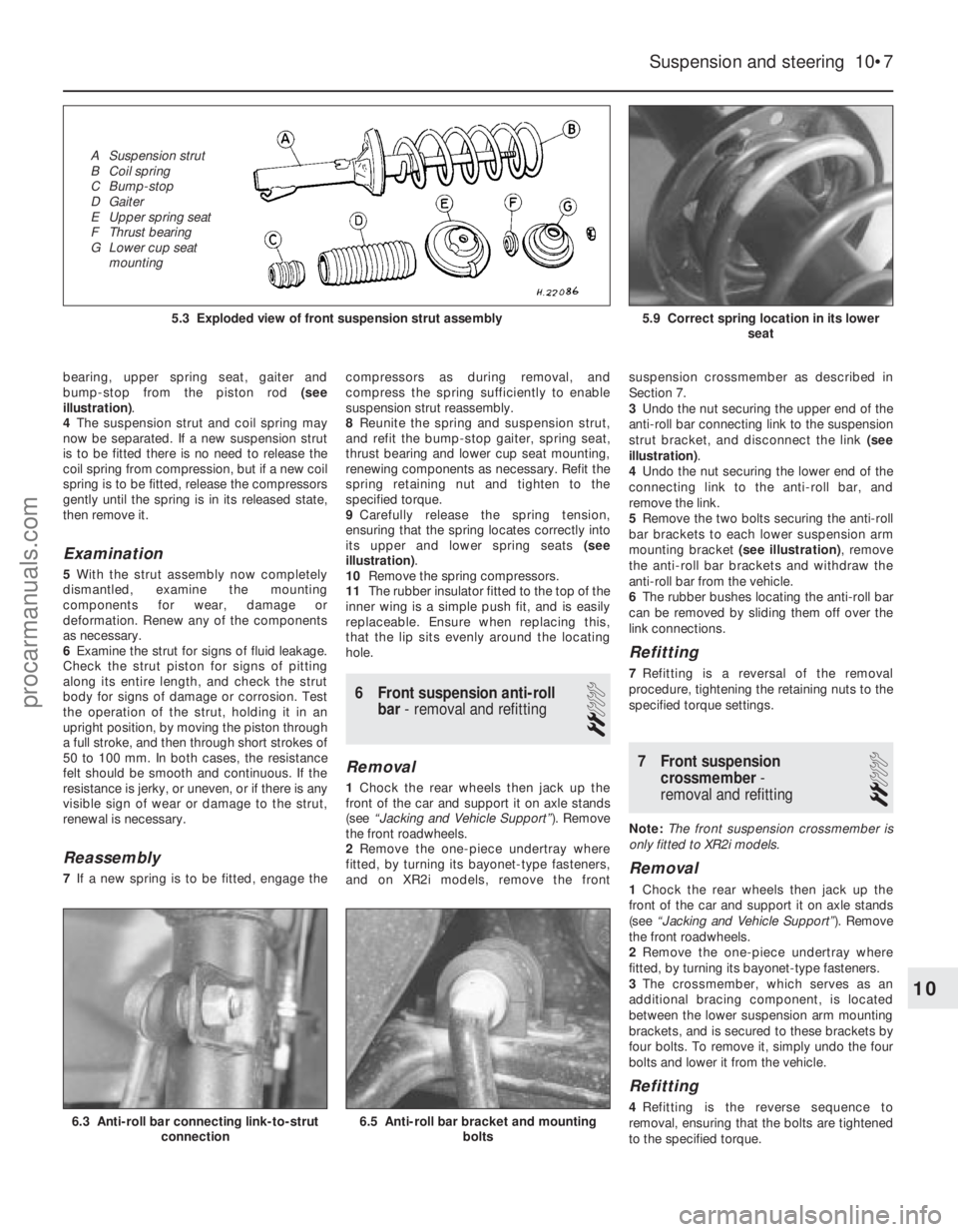
bearing, upper spring seat, gaiter and
bump-stop from the piston rod (see
illustration) .
4 The suspension strut and coil spring may
now be separated. If a new suspension strut
is to be fitted there is no need to release the
coil spring from compression, but if a new coil
spring is to be fitted, release the compressors
gently until the spring is in its released state,
then remove it.
Examination
5 With the strut assembly now completely
dismantled, examine the mounting
components for wear, damage or
deformation. Renew any of the components
as necessary.
6 Examine the strut for signs of fluid leakage.
Check the strut piston for signs of pitting
along its entire length, and check the strut
body for signs of damage or corrosion. Test
the operation of the strut, holding it in an
upright position, by moving the piston through
a full stroke, and then through short strokes of
50 to 100 mm. In both cases, the resistance
felt should be smooth and continuous. If the
resistance is jerky, or uneven, or if there is any
visible sign of wear or damage to the strut,
renewal is necessary.
Reassembly
7 If a new spring is to be fitted, engage the compressors as during removal, and
compress the spring sufficiently to enable
suspension strut reassembly.
8
Reunite the spring and suspension strut,
and refit the bump-stop gaiter, spring seat,
thrust bearing and lower cup seat mounting,
renewing components as necessary. Refit the
spring retaining nut and tighten to the
specified torque.
9 Carefully release the spring tension,
ensuring that the spring locates correctly into
its upper and lower spring seats (see
illustration) .
10 Remove the spring compressors.
11 The rubber insulator fitted to the top of the
inner wing is a simple push fit, and is easily
replaceable. Ensure when replacing this,
that the lip sits evenly around the locating
hole.
6 Front suspension anti-roll
bar - removal and refitting
2
Removal
1Chock the rear wheels then jack up the
front of the car and support it on axle stands
(see “Jacking and Vehicle Support” ). Remove
the front roadwheels.
2 Remove the one-piece undertray where
fitted, by turning its bayonet-type fasteners,
and on XR2i models, remove the front suspension crossmember as described in
Section 7.
3
Undo the nut securing the upper end of the
anti-roll bar connecting link to the suspension
strut bracket, and disconnect the link (see
illustration) .
4 Undo the nut securing the lower end of the
connecting link to the anti-roll bar, and
remove the link.
5 Remove the two bolts securing the anti-roll
bar brackets to each lower suspension arm
mounting bracket (see illustration), remove
the anti-roll bar brackets and withdraw the
anti-roll bar from the vehicle.
6 The rubber bushes locating the anti-roll bar
can be removed by sliding them off over the
link connections.
Refitting
7 Refitting is a reversal of the removal
procedure, tightening the retaining nuts to the
specified torque settings.
7 Front suspension crossmember -
removal and refitting
2
Note: The front suspension crossmember is
only fitted to XR2i models.
Removal
1 Chock the rear wheels then jack up the
front of the car and support it on axle stands
(see “Jacking and Vehicle Support” ). Remove
the front roadwheels.
2 Remove the one-piece undertray where
fitted, by turning its bayonet-type fasteners.
3 The crossmember, which serves as an
additional bracing component, is located
between the lower suspension arm mounting
brackets, and is secured to these brackets by
four bolts. To remove it, simply undo the four
bolts and lower it from the vehicle.
Refitting
4 Refitting is the reverse sequence to
removal, ensuring that the bolts are tightened
to the specified torque.
Suspension and steering 10•7
5.9 Correct spring location in its lower seat5.3 Exploded view of front suspension strut assembly
6.5 Anti-roll bar bracket and mountingbolts6.3 Anti-roll bar connecting link-to-strutconnection
10
1595Ford Fiesta Remake
A Suspension strut
B Coil spring
C Bump-stop
D Gaiter
E Upper spring seat
F Thrust bearing
G Lower cup seat
mountingprocarmanuals.com
http://vnx.su
Page 201 of 296

8 Front suspension lower arm- removal and refitting
3
Removal
1Chock the rear wheels then jack up the
front of the car and support it on axle stands
(see “Jacking and Vehicle Support” ). Remove
the appropriate front roadwheel.
2 Remove the one-piece undertray (where
fitted), by turning its bayonet-type fasteners.
3 If lower arm mounting brackets are to be
removed on XR2i models, remove the front
suspension crossmember as described in the
previous Section.
4 Unscrew and remove the lower arm
balljoint-to-spindle carrier pinch-bolt. Prise
the joint open using a large flat-bladed tool,
and detach the balljoint from the spindle
carrier. Take care not to damage the balljoint
seal during the separation procedures.
5 Where an anti-roll bar is fitted, undo the two
bolts and remove the clamp bracket.
6 To remove the lower arm from its mounting
bracket, undo the two bolts that pass through
the vertical bushes, remove the bolts and
pull the arm clear (see illustration). Note that
new bolts will be required for refitting.
7 The lower arm mounting brackets are each retained by five bolts. To remove a mounting
bracket, undo the five bolts and lower it from
the vehicle.
8
If the balljoint and/or the inboard mounting
bushes are found to be in poor condition, the
complete suspension arm must be renewed.
The suspension arm must also be renewed if
it has suffered structural damage.Refitting
9 Insert the lower arm into its mounting
bracket and fit the two bolts that pass through
the vertical bushes finger tight only at this
stage.
10 Fit the lower arm mounting bracket to the
vehicle, ensuring that the locating dowel is
correctly located in its recess. One of the five
bolts securing the mounting bracket has a
locating shoulder and a larger thread
diameter, and this should be fitted first to
ensure correct alignment of the mounting
bracket to the vehicle (see illustration). Refit
the other four bolts and tighten all five to the
specified torque.
11 Refit the anti-roll bar bracket and front
suspension crossmember, as applicable, in
accordance with the relevant Sections of this
Chapter.
12 Locate the lower suspension arm balljoint
into the spindle carrier assembly then fit and
tighten the pinch-bolt and nut to the specified
torque. Note that the bolt must locate to the annular groove on the balljoint spindle.
13
Refit the roadwheel, remove the axle
stands and lower the vehicle to the ground.
14 Tighten the wheel nuts to the specified
torque.
15 Tighten the lower arm-to-lower arm
mounting bracket bolts, that pass through the
vertical bushes, by the torque-to-yield method
as follows. Note that the weight of the vehicle
must be on the roadwheels for these
procedures and new bolts must be used.
Tighten the bolts to the Stage 1 torque setting
given in the Specifications, then back off to
zero torque (Stage 2). Retighten to the
Stage 3 torque setting, then tighten further
through the angle specified for Stage 4, using
an angle-tightening gauge. It is vitally
important that these procedures are followed
and that the bolts are not subjected to further
rotation which could result in them failing. The
torque-to-yield method must be followed
every time that these bolts are disturbed.
16 Raise the front of the vehicle again and
support it securely on axle stands to refit the
one-piece undertray (where applicable).
9 Rear hub bearings -
renewal
3
1 Chock the front wheels then jack up the
rear of the car and support it on axle stands
(see “Jacking and Vehicle Support” ). Remove
the appropriate rear roadwheel.
2 Check that the handbrake is released, then
remove the rubber blanking plug from the
inside face of the brake backplate, reach
through with a suitable screwdriver, and
release the automatic brake adjuster by
levering the catch from the pawl.
3 Prise free the outer grease cap from the
centre of the hub (see illustration). The cap
will be deformed during its removal, and will
need to be renewed when the hub is refitted.
4 Unscrew and remove the hub nut, but note
that the hub nut threads are “handed”
according to side - right-hand to right, left-
hand to left (see illustration) . A left-hand
thread unscrews in a clockwisedirection.
5 Withdraw the brake drum/hub from the
spindle of the rear stub axle (see illustration).
10•8 Suspension and steering
9.5 Slide off the wheel hub/brake drum
unit9.4 Undoing the hub bearing retaining nut9.3 Removing the outer grease cap fromthe hub centre
8.10 Lower suspension arm and mountingbracket arrangement
A Arm-to-mounting bracket bolts
B Special “shouldered” locating bolt
C Mounting bracket retaining bolts
8.6 Lower suspension arm arrangement in its mounting bracket
1595Ford Fiesta Remakeprocarmanuals.com
http://vnx.su
Page 203 of 296
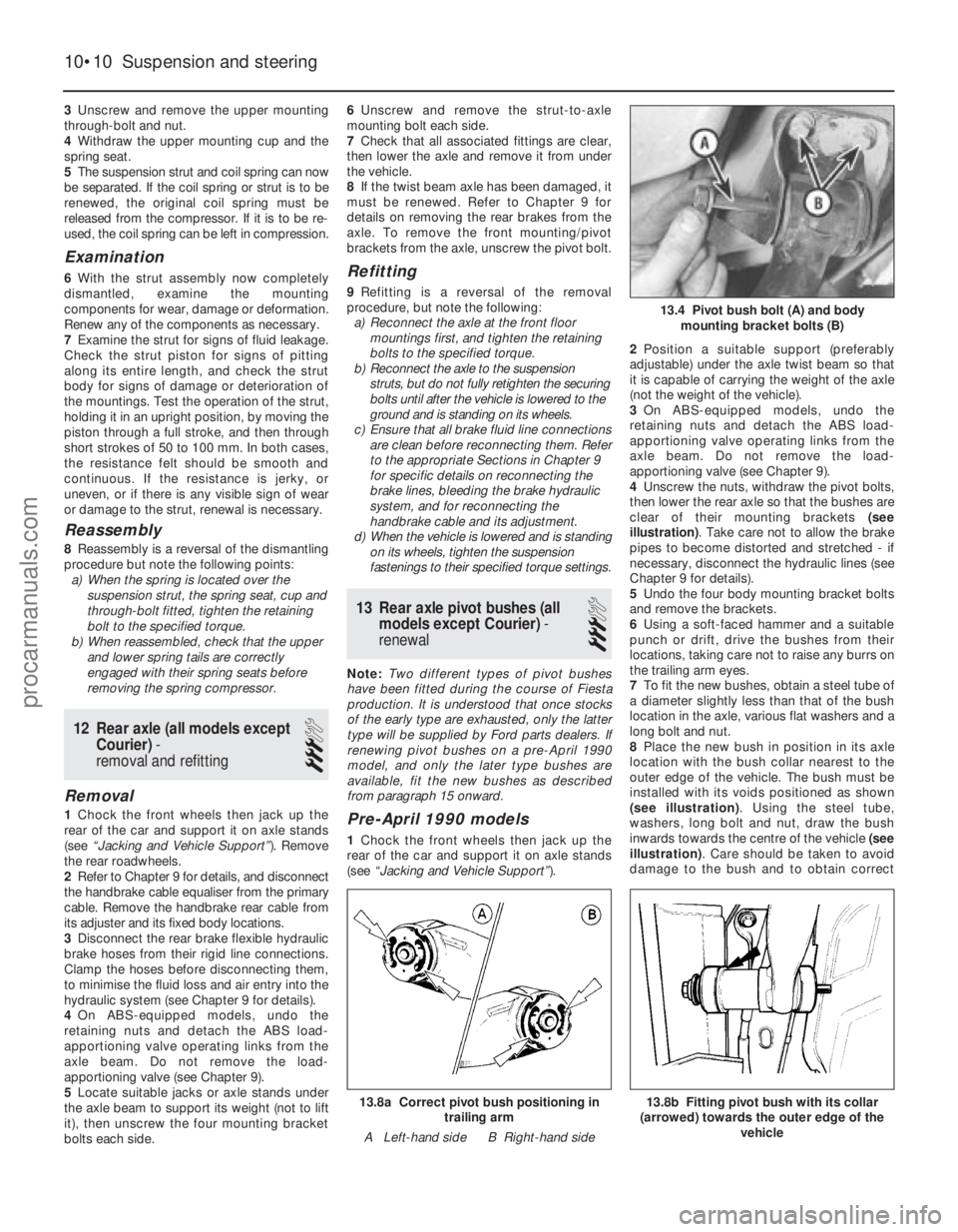
3Unscrew and remove the upper mounting
through-bolt and nut.
4 Withdraw the upper mounting cup and the
spring seat.
5 The suspension strut and coil spring can now
be separated. If the coil spring or strut is to be
renewed, the original coil spring must be
released from the compressor. If it is to be re-
used, the coil spring can be left in compression.
Examination
6 With the strut assembly now completely
dismantled, examine the mounting
components for wear, damage or deformation.
Renew any of the components as necessary.
7 Examine the strut for signs of fluid leakage.
Check the strut piston for signs of pitting
along its entire length, and check the strut
body for signs of damage or deterioration of
the mountings. Test the operation of the strut,
holding it in an upright position, by moving the
piston through a full stroke, and then through
short strokes of 50 to 100 mm. In both cases,
the resistance felt should be smooth and
continuous. If the resistance is jerky, or
uneven, or if there is any visible sign of wear
or damage to the strut, renewal is necessary.
Reassembly
8 Reassembly is a reversal of the dismantling
procedure but note the following points: a) When the spring is located over the
suspension strut, the spring seat, cup and
through-bolt fitted, tighten the retaining
bolt to the specified torque.
b) When reassembled, check that the upper
and lower spring tails are correctly
engaged with their spring seats before
removing the spring compressor.
12 Rear axle (all models except
Courier) -
removal and refitting
3
Removal
1 Chock the front wheels then jack up the
rear of the car and support it on axle stands
(see “Jacking and Vehicle Support” ). Remove
the rear roadwheels.
2 Refer to Chapter 9 for details, and disconnect
the handbrake cable equaliser from the primary
cable. Remove the handbrake rear cable from
its adjuster and its fixed body locations.
3 Disconnect the rear brake flexible hydraulic
brake hoses from their rigid line connections.
Clamp the hoses before disconnecting them,
to minimise the fluid loss and air entry into the
hydraulic system (see Chapter 9 for details).
4 On ABS-equipped models, undo the
retaining nuts and detach the ABS load-
apportioning valve operating links from the
axle beam. Do not remove the load-
apportioning valve (see Chapter 9).
5 Locate suitable jacks or axle stands under
the axle beam to support its weight (not to lift
it), then unscrew the four mounting bracket
bolts each side. 6
Unscrew and remove the strut-to-axle
mounting bolt each side.
7 Check that all associated fittings are clear,
then lower the axle and remove it from under
the vehicle.
8 If the twist beam axle has been damaged, it
must be renewed. Refer to Chapter 9 for
details on removing the rear brakes from the
axle. To remove the front mounting/pivot
brackets from the axle, unscrew the pivot bolt.
Refitting
9 Refitting is a reversal of the removal
procedure, but note the following: a) Reconnect the axle at the front floor mountings first, and tighten the retaining
bolts to the specified torque.
b) Reconnect the axle to the suspension struts, but do not fully retighten the securing
bolts until after the vehicle is lowered to the
ground and is standing on its wheels.
c) Ensure that all brake fluid line connections are clean before reconnecting them. Refer
to the appropriate Sections in Chapter 9
for specific details on reconnecting the
brake lines, bleeding the brake hydraulic
system, and for reconnecting the
handbrake cable and its adjustment.
d) When the vehicle is lowered and is standing
on its wheels, tighten the suspension
fastenings to their specified torque settings.
13 Rear axle pivot bushes (all
models except Courier) -
renewal
3
Note: Two different types of pivot bushes
have been fitted during the course of Fiesta
production. It is understood that once stocks
of the early type are exhausted, only the latter
type will be supplied by Ford parts dealers. If
renewing pivot bushes on a pre-April 1990
model, and only the later type bushes are
available, fit the new bushes as described
from paragraph 15 onward.
Pre-April 1990 models
1 Chock the front wheels then jack up the
rear of the car and support it on axle stands
(see “Jacking and Vehicle Support” ).2
Position a suitable support (preferably
adjustable) under the axle twist beam so that
it is capable of carrying the weight of the axle
(not the weight of the vehicle).
3 On ABS-equipped models, undo the
retaining nuts and detach the ABS load-
apportioning valve operating links from the
axle beam. Do not remove the load-
apportioning valve (see Chapter 9).
4 Unscrew the nuts, withdraw the pivot bolts,
then lower the rear axle so that the bushes are
clear of their mounting brackets (see
illustration) . Take care not to allow the brake
pipes to become distorted and stretched - if
necessary, disconnect the hydraulic lines (see
Chapter 9 for details).
5 Undo the four body mounting bracket bolts
and remove the brackets.
6 Using a soft-faced hammer and a suitable
punch or drift, drive the bushes from their
locations, taking care not to raise any burrs on
the trailing arm eyes.
7 To fit the new bushes, obtain a steel tube of
a diameter slightly less than that of the bush
location in the axle, various flat washers and a
long bolt and nut.
8 Place the new bush in position in its axle
location with the bush collar nearest to the
outer edge of the vehicle. The bush must be
installed with its voids positioned as shown
(see illustration) . Using the steel tube,
washers, long bolt and nut, draw the bush
inwards towards the centre of the vehicle (see
illustration) . Care should be taken to avoid
damage to the bush and to obtain correct
10•10 Suspension and steering
13.8b Fitting pivot bush with its collar
(arrowed) towards the outer edge of the vehicle13.8a Correct pivot bush positioning intrailing arm
A Left-hand side B Right-hand side
13.4 Pivot bush bolt (A) and body mounting bracket bolts (B)
1595Ford Fiesta Remakeprocarmanuals.com
http://vnx.su
Page 204 of 296
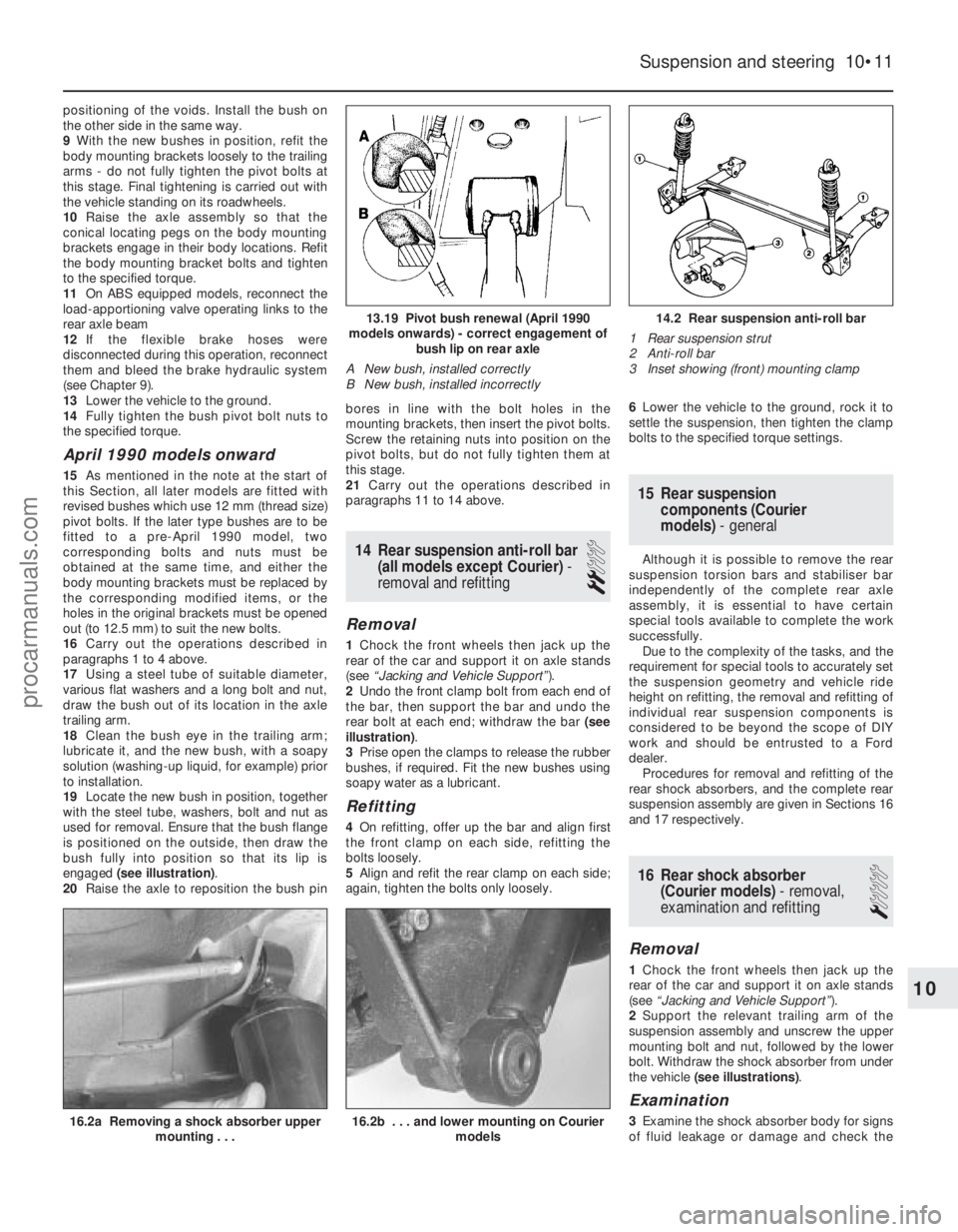
positioning of the voids. Install the bush on
the other side in the same way.
9With the new bushes in position, refit the
body mounting brackets loosely to the trailing
arms - do not fully tighten the pivot bolts at
this stage. Final tightening is carried out with
the vehicle standing on its roadwheels.
10 Raise the axle assembly so that the
conical locating pegs on the body mounting
brackets engage in their body locations. Refit
the body mounting bracket bolts and tighten
to the specified torque.
11 On ABS equipped models, reconnect the
load-apportioning valve operating links to the
rear axle beam
12 If the flexible brake hoses were
disconnected during this operation, reconnect
them and bleed the brake hydraulic system
(see Chapter 9).
13 Lower the vehicle to the ground.
14 Fully tighten the bush pivot bolt nuts to
the specified torque.
April 1990 models onward
15 As mentioned in the note at the start of
this Section, all later models are fitted with
revised bushes which use 12 mm (thread size)
pivot bolts. If the later type bushes are to be
fitted to a pre-April 1990 model, two
corresponding bolts and nuts must be
obtained at the same time, and either the
body mounting brackets must be replaced by
the corresponding modified items, or the
holes in the original brackets must be opened
out (to 12.5 mm) to suit the new bolts.
16 Carry out the operations described in
paragraphs 1 to 4 above.
17 Using a steel tube of suitable diameter,
various flat washers and a long bolt and nut,
draw the bush out of its location in the axle
trailing arm.
18 Clean the bush eye in the trailing arm;
lubricate it, and the new bush, with a soapy
solution (washing-up liquid, for example) prior
to installation.
19 Locate the new bush in position, together
with the steel tube, washers, bolt and nut as
used for removal. Ensure that the bush flange
is positioned on the outside, then draw the
bush fully into position so that its lip is
engaged (see illustration) .
20 Raise the axle to reposition the bush pin bores in line with the bolt holes in the
mounting brackets, then insert the pivot bolts.
Screw the retaining nuts into position on the
pivot bolts, but do not fully tighten them at
this stage.
21
Carry out the operations described in
paragraphs 11 to 14 above.
14 Rear suspension anti-roll bar (all models except Courier) -
removal and refitting
2
Removal
1 Chock the front wheels then jack up the
rear of the car and support it on axle stands
(see “Jacking and Vehicle Support” ).
2 Undo the front clamp bolt from each end of
the bar, then support the bar and undo the
rear bolt at each end; withdraw the bar (see
illustration) .
3 Prise open the clamps to release the rubber
bushes, if required. Fit the new bushes using
soapy water as a lubricant.
Refitting
4 On refitting, offer up the bar and align first
the front clamp on each side, refitting the
bolts loosely.
5 Align and refit the rear clamp on each side;
again, tighten the bolts only loosely. 6
Lower the vehicle to the ground, rock it to
settle the suspension, then tighten the clamp
bolts to the specified torque settings.
15 Rear suspension components (Courier
models) - general
Although it is possible to remove the rear
suspension torsion bars and stabiliser bar
independently of the complete rear axle
assembly, it is essential to have certain
special tools available to complete the work
successfully.
Due to the complexity of the tasks, and the
requirement for special tools to accurately set
the suspension geometry and vehicle ride
height on refitting, the removal and refitting of
individual rear suspension components is
considered to be beyond the scope of DIY
work and should be entrusted to a Ford
dealer. Procedures for removal and refitting of the
rear shock absorbers, and the complete rear
suspension assembly are given in Sections 16
and 17 respectively.
16 Rear shock absorber (Courier models) - removal,
examination and refitting
1
Removal
1 Chock the front wheels then jack up the
rear of the car and support it on axle stands
(see “Jacking and Vehicle Support” ).
2 Support the relevant trailing arm of the
suspension assembly and unscrew the upper
mounting bolt and nut, followed by the lower
bolt. Withdraw the shock absorber from under
the vehicle (see illustrations) .
Examination
3Examine the shock absorber body for signs
of fluid leakage or damage and check the
Suspension and steering 10•11
14.2 Rear suspension anti-roll bar
1 Rear suspension strut
2 Anti-roll bar
3 Inset showing (front) mounting clamp13.19 Pivot bush renewal (April 1990
models onwards) - correct engagement of bush lip on rear axle
A New bush, installed correctly
B New bush, installed incorrectly
16.2b . . . and lower mounting on Courier models16.2a Removing a shock absorber uppermounting . . .
10
1595Ford Fiesta Remakeprocarmanuals.com
http://vnx.su